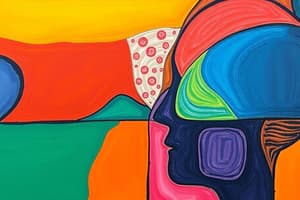Podcast
Questions and Answers
Definition
Definition
untersucht allgemeine Gesetzmässigkeiten des menschlichen Erlebens und Verhaltens
Biopsychosozialer Ansatz
Biopsychosozialer Ansatz
vereint biologische, psychosoziale und soziokulturelle Einflüsse aufs Verhalten und mentale Prozesse
Biologische Einflüsse und Evolution: Darwins Evolutionstheorie
Biologische Einflüsse und Evolution: Darwins Evolutionstheorie
Anpassung an Umwelt durch natürliche Selektion (Genkombination, Variation, Selektion, Evolution)
Gehirne unterschiedlicher Söugetiere
Gehirne unterschiedlicher Söugetiere
Wahrnehmung und Evolution
Wahrnehmung und Evolution
Entwicklung des Gehirns und Umwelteinflüsse
Entwicklung des Gehirns und Umwelteinflüsse
Hollow-Face-Illusion
Hollow-Face-Illusion
Gesichtsverarbeitung: Thompson Täuschung
Gesichtsverarbeitung: Thompson Täuschung
Gesichtsverarbeitung: Rotierte Gesichter
Gesichtsverarbeitung: Rotierte Gesichter
Objektwahrmehmung und Umwelt
Objektwahrmehmung und Umwelt
Sozialer Kontext und Wahrnehmung
Sozialer Kontext und Wahrnehmung
Sensorische Ausstattung
Sensorische Ausstattung
Prosopagnosie (Gesichtsblindheit)
Prosopagnosie (Gesichtsblindheit)
Bottom-up-Verarbeitung
Bottom-up-Verarbeitung
Top-down Verarbeitung
Top-down Verarbeitung
Empfindung
Empfindung
Wahrnehmung
Wahrnehmung
Absolute Schwelle
Absolute Schwelle
Unterschiedsschwelle (JND)
Unterschiedsschwelle (JND)
Webergesetz
Webergesetz
sensorische Adaption
sensorische Adaption
Kontexteffekte
Kontexteffekte
Wahrnehmungsset
Wahrnehmungsset
Emotionen und Motivation
Emotionen und Motivation
Wahrnehmung im sozialen Kontext
Wahrnehmung im sozialen Kontext
Auge: Licht als physikalischer Reiz
Auge: Licht als physikalischer Reiz
Farbmischung
Farbmischung
Auge
Auge
Iris und Pupille
Iris und Pupille
Blinder Fleck
Blinder Fleck
Sehschärfe
Sehschärfe
Farbwahrnehmung: Dreifarbentheorie
Farbwahrnehmung: Dreifarbentheorie
Gegenfarbtheorie
Gegenfarbtheorie
Dunkeladaption
Dunkeladaption
Vom Auge zum Gehirn
Vom Auge zum Gehirn
Dorsaler Strom
Dorsaler Strom
Ventraler Strom
Ventraler Strom
Läsion
Läsion
Okzipitalcortex (primärer visueller Cortex)
Okzipitalcortex (primärer visueller Cortex)
Parallelverarbeitung
Parallelverarbeitung
Gestaltgesetzte: Nähe
Gestaltgesetzte: Nähe
Gestaltgesetze: Ähnlichkeit
Gestaltgesetze: Ähnlichkeit
Gestaltgesetz: Kontinuität
Gestaltgesetz: Kontinuität
Gestaltgesetz: Zusammenhang
Gestaltgesetz: Zusammenhang
Gestaltgesetz: Geschlossenheit
Gestaltgesetz: Geschlossenheit
Tiefenwahrnehmung
Tiefenwahrnehmung
Binikulare Hinweisreize
Binikulare Hinweisreize
Monokulare Hinweisreize
Monokulare Hinweisreize
Mobokulare Hinweisreize
Mobokulare Hinweisreize
Flashcards
Psychology
Psychology
The study of general laws governing human experience and behavior.
Biopsychosocial Approach
Biopsychosocial Approach
An approach that combines biological, psychological, and sociocultural influences on behavior and mental processes.
Darwin's Theory of Evolution
Darwin's Theory of Evolution
The theory that explains how organisms adapt to their environment through natural selection.
Human Brain Evolution
Human Brain Evolution
Signup and view all the flashcards
Perception and Evolution
Perception and Evolution
Signup and view all the flashcards
Brain Development and Environment
Brain Development and Environment
Signup and view all the flashcards
Hollow-Face Illusion
Hollow-Face Illusion
Signup and view all the flashcards
Thompson Illusion
Thompson Illusion
Signup and view all the flashcards
Processing Rotated Faces
Processing Rotated Faces
Signup and view all the flashcards
Object Perception and Environment
Object Perception and Environment
Signup and view all the flashcards
Social Context and Perception
Social Context and Perception
Signup and view all the flashcards
Sensory Equipment
Sensory Equipment
Signup and view all the flashcards
Prosopagnosia (Face Blindness)
Prosopagnosia (Face Blindness)
Signup and view all the flashcards
Bottom-up Processing
Bottom-up Processing
Signup and view all the flashcards
Top-down Processing
Top-down Processing
Signup and view all the flashcards
Sensation
Sensation
Signup and view all the flashcards
Perception
Perception
Signup and view all the flashcards
Absolute Threshold
Absolute Threshold
Signup and view all the flashcards
Difference Threshold (JND)
Difference Threshold (JND)
Signup and view all the flashcards
Weber's Law
Weber's Law
Signup and view all the flashcards
Sensory Adaptation
Sensory Adaptation
Signup and view all the flashcards
Context Effects
Context Effects
Signup and view all the flashcards
Perceptual Set
Perceptual Set
Signup and view all the flashcards
Emotions and Motivation
Emotions and Motivation
Signup and view all the flashcards
Perception in Social Context
Perception in Social Context
Signup and view all the flashcards
Light as a Physical Stimulus
Light as a Physical Stimulus
Signup and view all the flashcards
Color Mixing
Color Mixing
Signup and view all the flashcards
Eye
Eye
Signup and view all the flashcards
Iris and Pupil
Iris and Pupil
Signup and view all the flashcards
Blind Spot
Blind Spot
Signup and view all the flashcards
Visual Acuity
Visual Acuity
Signup and view all the flashcards
Trichromatic Theory
Trichromatic Theory
Signup and view all the flashcards
Opponent-Process Theory
Opponent-Process Theory
Signup and view all the flashcards
Dark Adaptation
Dark Adaptation
Signup and view all the flashcards
From the Eye to the Brain
From the Eye to the Brain
Signup and view all the flashcards
Dorsal Stream
Dorsal Stream
Signup and view all the flashcards
Ventral Stream
Ventral Stream
Signup and view all the flashcards
Lesion
Lesion
Signup and view all the flashcards
Occipital Cortex (Primary Visual Cortex)
Occipital Cortex (Primary Visual Cortex)
Signup and view all the flashcards
Parallel Processing
Parallel Processing
Signup and view all the flashcards
Gestalt Law: Proximity
Gestalt Law: Proximity
Signup and view all the flashcards
Gestalt Law: Similarity
Gestalt Law: Similarity
Signup and view all the flashcards
Gestalt Law: Continuity
Gestalt Law: Continuity
Signup and view all the flashcards
Gestalt Law: Connectedness
Gestalt Law: Connectedness
Signup and view all the flashcards
Gestalt Law: Closure
Gestalt Law: Closure
Signup and view all the flashcards
Depth Perception
Depth Perception
Signup and view all the flashcards
Binocular Depth Cues
Binocular Depth Cues
Signup and view all the flashcards
Monocular Depth Cues
Monocular Depth Cues
Signup and view all the flashcards
Monocular Depth Cues
Monocular Depth Cues
Signup and view all the flashcards


